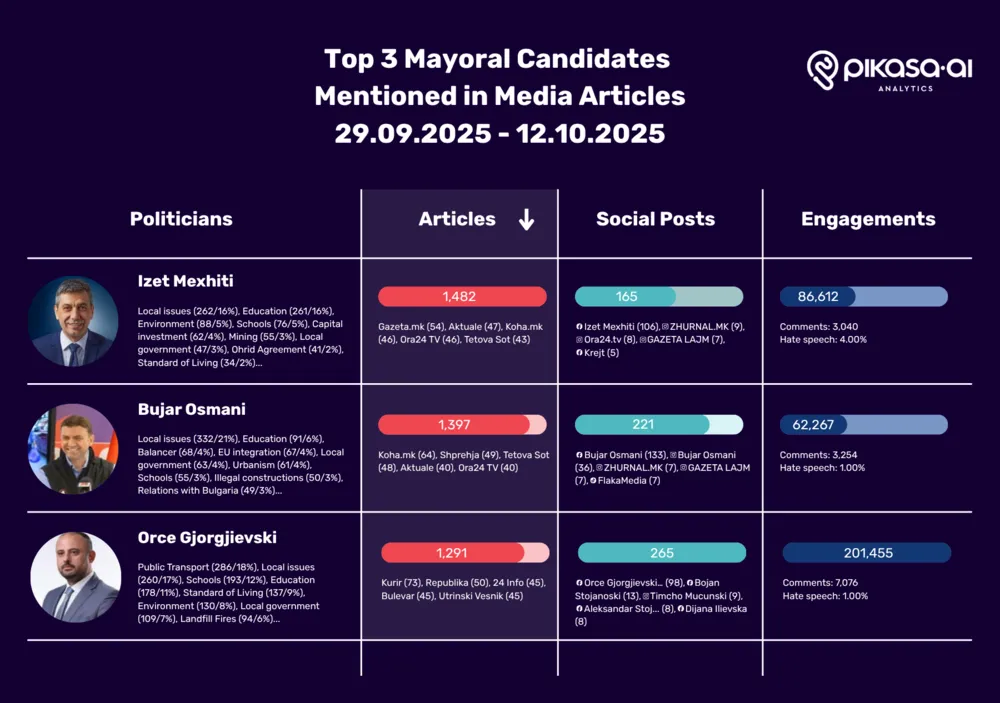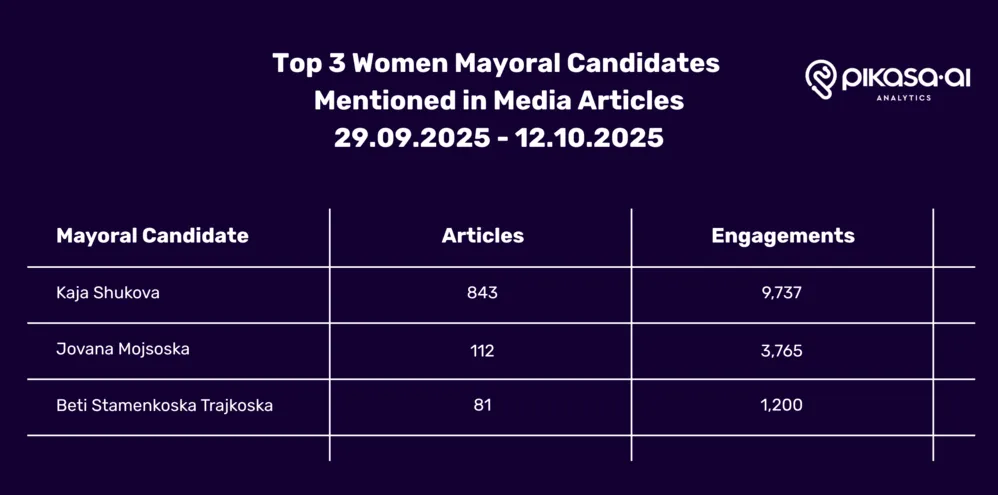Seeing the Unseen: Why Real-Time Media Monitoring Matters in Modern Election
Analytics.live, Pikasa.ai’s real-time media monitoring platform, delivers powerful insights through AI-powered media analysis and social media monitoring tools. By analyzing thousands of digital and social posts, it provides data analytics for media, uncovering sentiment shifts, audience reactions, and emerging narratives. This case study of North Macedonia’s 2025 elections shows how media coverage analytics, media sentiment analysis, and brand reputation monitoring strengthen transparency, accountability, and audience engagement tracking in modern democracies.
Elections are no longer fought only on rallies and billboards. In the digital age, campaign narratives travel through local news portals, Facebook pages, YouTube channels, and messenger apps. These platforms give candidates a direct line to voters, but they also amplify disinformation and hate speech.
Pikasa Analytics monitored online and social media coverage of North Macedonia’s local election campaign from 29 September to 12 October 2025. Our dataset combines 36,196 posts and articles across dozens of digital web news portals and social platforms that generate almost 3 million engagements. We used this dataset to track which candidates dominated the conversation, what issues resonated with audiences, and where hate speech appeared. Below we share key insights and explain why media monitoring matters for democracy and fair elections.
Why media monitoring matters
- Gauging public sentiment and engagement
Modern campaigns depend on social media engagement. Our monitoring shows that posts mentioning some mayoral candidates generated tens of thousands of likes and comments. By tracking which messages inspire enthusiasm or backlash, campaign teams can adjust their messaging. Media monitoring also highlights what citizens care about - whether it is public transport, education or local services, and whether certain communities are being marginalised.
- Ensuring transparency and accountability
Election observers and factchecking organisations need timely access to data. A systematic monitoring platform centralises information from hundreds of sources, making it easier to spot coordinated smear campaigns, misinformation networks or suspiciously high volumes of paid ads. Data-driven monitoring is the first step towards that goal.
- What we found: key metrics from the campaign
The table below summarises coverage and engagement for the three mayoral candidates who dominated online conversation. Figures reflect the 29 Sept - 12 Oct 2025 monitoring period. The chart shows how these candidates compare in terms of article volume. Izet Mexhiti and Bujar Osmani received the most coverage, reflecting their prominence in Albanian language media, while Orce Gjorgjievski dominated Macedonian language portals.

Chart 1: Top 3 mayoral candidates mentioned in media articles
Engagement patterns
While Orce Gjorgjievski had fewer articles than his Albanian counterparts, his posts triggered far more interaction. He accumulated more than 201455 engagements, almost two and a half times the combined likes, comments and shares of Izet Mexhiti. This suggests that his focus on concrete issues like public transport and schools resonates strongly with urban voters. The stacked bar chart below breaks down the likes, comments, and shares for each candidate.
On average, pieces about Orce received 134 engagements, while those about Bujar averaged 41 and Izet averaged 57 per piece. Orce’s strategy of using Facebook community pages and engaging with high-profile supporters may explain the difference.
Issues that drove conversations
Our analysis shows that local issues, education, and environment were the most common themes associated with Izet Mexhiti. For Bujar Osmani, the conversation also included EU integration and the “Balancer”. Orce Gjorgjievski’s coverage centered on public transport, schools, and municipal services. These patterns align with our sentiment analysis: posts highlighting tangible community projects attracted more positive reactions than those focusing on abstract political positioning.
Gender imbalance
Only one woman, Kaja Shukova, appears among the top ten candidates by article count. She accrued 843 pieces and generated around 9737 engagements, respectable figures but still less coverage than her male counterparts. Media monitoring allows campaigns and watchdogs to quantify these disparities and advocate for balanced representation.

Chart 2: Top 3 women mayoral candidates mentioned in media articles
What Pikasa Analytics brings to the table
Pikasa’s platform aggregates data from traditional news outlets, television websites, Facebook pages, Instagram profiles, and TikTok channels into a single dashboard. For this case study we monitored more than 36k posts across Albanian and Macedonian language sources. Our algorithms automatically classify content by topic, detect spikes in hateful language, and visualise engagement trends. Analysts can filter results by candidate, region or issue and cross-reference them with external events. Realtime alerts help campaigns respond swiftly to misinformation or coordinate counternarratives.
Beyond campaigns, our monitoring supports civil society groups and journalists. By exposing coordinated smear campaigns and quantifying hate speech, data from Pikasa empowers advocacy for stronger content moderation policies and media literacy initiatives. Analytics.live use systematic monitoring to categorise hate, perform discourse analysis and alert performance. And teams complement these efforts by providing scalable analytics and custom reporting.
Conclusion
North Macedonia’s 2025 local election campaign illustrates how online and social media narratives shape political outcomes. In just two weeks, candidates generated thousands of posts and tens of thousands of engagements. The data reveal striking contrasts: Orce Gjorgjievski’s targeted messaging on public services sparked far more interaction than the broader agendas of Izet Mexhiti and Bujar Osmani; yet the latter dominated digital news coverage. Meanwhile, only one woman cracked the top ten in coverage, reflecting persistent gender imbalances.
These insights would remain hidden without systematic monitoring. By collecting, classifying and analysing digital content, platforms like Pikasa help safeguard the integrity of elections, inform media literacy programmes and promote healthier public discourse. Media monitoring is not just a technical exercise - it is a democratic necessity.
Written by
Natasha Dimova
October 15, 2025